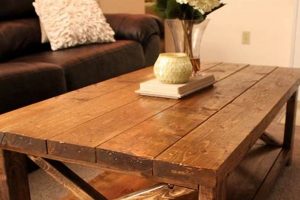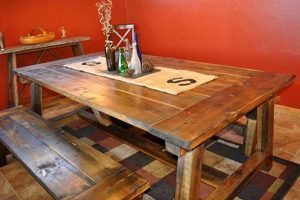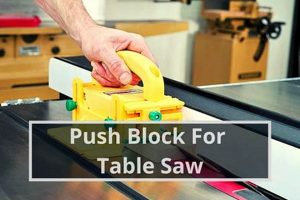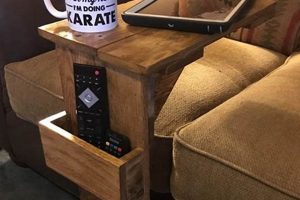Numerals or identifiers placed on reception tables at a wedding serve the practical purpose of directing guests to their assigned seats. These indicators can range from simple printed cards to elaborate decorative creations. The intent is efficient organization and minimizing guest confusion during seating.
Using handcrafted or personalized table identifiers offers several advantages. This approach allows for significant cost savings compared to professionally produced items. It provides an opportunity to inject individual style and themes reflective of the couple’s aesthetic preferences. Historically, such personalized elements demonstrate attention to detail, enhancing the overall guest experience and creating memorable moments.
The following sections will explore diverse techniques for constructing unique and visually appealing seating designations, encompassing various materials, design considerations, and approaches suitable for different skill levels and wedding themes.
Guidance for Creating Bespoke Table Identifiers
The crafting of personalized reception identifiers necessitates careful consideration of several factors to ensure both aesthetic appeal and functional efficacy. The following tips provide guidance for constructing these elements effectively.
Tip 1: Material Selection: Choose materials that complement the overall wedding theme. Options range from natural elements such as wood slices and foliage to more refined materials like acrylic or metallic cardstock. Consider the durability and visual impact of each material.
Tip 2: Font and Typography: Employ legible fonts that are consistent with the wedding’s design aesthetic. Sans-serif fonts often provide clarity, while serif fonts can evoke a more formal atmosphere. Ensure the font size is easily readable from a reasonable distance.
Tip 3: Embellishment and Decoration: Incorporate embellishments judiciously. Ribbons, paint, glitter, and small decorative objects can enhance the visual appeal. However, avoid overcrowding or obscuring the primary numeral or identifier.
Tip 4: Base and Support: Consider the stability of the table identifiers. Options include freestanding designs with sturdy bases or methods for attaching them to existing centerpieces. Ensure they will not easily topple or be displaced.
Tip 5: Numbering System Consistency: Maintain a consistent numbering or naming convention across all tables. Avoid gaps in the sequence or inconsistencies in the presentation of the identifiers.
Tip 6: Visibility and Placement: Position the identifiers in a location that is easily visible to guests entering the reception area. Ensure they are not obscured by centerpieces or other table decorations.
Tip 7: Test Prototypes: Create prototypes to assess the overall design, scale, and readability before producing the full set. This allows for adjustments and refinements to be made early in the process.
Effective planning and execution result in reception identifiers that not only serve their intended function but also contribute significantly to the overall aesthetic and ambiance of the event.
The subsequent sections will present specific project ideas and design inspirations for creating these unique elements.
1. Material Durability
Material durability is a critical factor in the creation and longevity of handcrafted reception identifiers. The choice of material directly influences the lifespan and visual appeal of these elements, impacting their functionality throughout the event and potentially beyond. Using readily degradable materials for an outdoor wedding risks damage from humidity or inclement weather. Conversely, robust materials ensure structural integrity and resistance to wear and tear.
For example, identifiers constructed from thin cardstock are susceptible to bending, tearing, or becoming disfigured during handling or due to environmental factors. This can lead to a diminished aesthetic and potentially require replacements during the reception. Alternatively, using wood, acrylic, or thicker cardstock offers greater resistance to damage and a more professional appearance. The initial cost difference between less durable and more durable materials is often offset by the reduced risk of needing replacements and the enhanced visual presentation.
In summary, material selection necessitates balancing cost considerations with the anticipated demands of the wedding environment. Prioritizing durability ensures that the identifiers maintain their aesthetic appeal and functional role throughout the event, contributing to a seamless and visually cohesive reception experience. Overlooking this aspect increases the likelihood of damage or premature degradation, detracting from the overall ambiance.
2. Font Legibility
Font legibility is a paramount concern in the design and creation of handcrafted seating identifiers. Inadequate font selection directly hinders the primary function of these elements: guiding guests to their assigned tables. When guests experience difficulty reading the numerals or names, confusion and delays ensue, disrupting the flow of the reception and potentially causing frustration. Thus, the choice of typeface has a direct impact on the organizational efficiency and overall guest experience.
Several factors contribute to font legibility in this context. The font size must be appropriately scaled to the distance from which guests are expected to view the identifier. Insufficient size renders the identifier useless. The font style must be clear and unambiguous; overly decorative or stylized fonts, while visually appealing in some contexts, often compromise readability. Finally, the contrast between the font color and the background color is crucial; insufficient contrast makes the identifier difficult to discern, particularly in dimly lit environments. An example includes use of a light grey font on a white background, which would prove illegible for most guests. In contrast, a bold, sans-serif font in a dark color against a light background promotes clear visibility.
In conclusion, font legibility represents a critical, non-negotiable aspect of designing effective table identifiers. Prioritizing clear, easily readable fonts over purely aesthetic considerations ensures the identifier fulfills its intended purpose efficiently, contributing to a well-organized and enjoyable wedding reception. Overlooking this detail compromises the function and negates the purpose of having visible table designations.
3. Design Cohesion
The concept of design cohesion represents a crucial element in the successful execution of handcrafted seating identifiers. A lack of cohesion negatively impacts the overall aesthetic and perceived professionalism of the wedding reception. Individual elements that clash or appear discordant detract from the visual harmony and can create a sense of disorganization. The absence of design cohesion creates visual noise that undercuts the overall aesthetic impact.
Examples of design cohesion include selecting colors, fonts, and materials that align with the wedding’s established theme or color palette. A rustic-themed wedding, for instance, benefits from identifiers crafted from natural wood, adorned with simple, earthy fonts, and employing colors found in nature. A modern, minimalist wedding would be better served by identifiers made from acrylic, featuring clean, sans-serif fonts, and incorporating a monochrome color scheme. Conversely, mismatched elements, such as ornate, calligraphy-style fonts on rustic wood slices or brightly colored plastic elements at a formal, black-tie event, disrupt the visual flow and weaken the intended impact. The table identifiers act as small billboards, communicating the overall design intentions.
In summary, prioritizing design cohesion ensures that the identifiers contribute positively to the wedding’s overall aesthetic. Achieving a cohesive design demonstrates attention to detail and enhances the guest experience. Neglecting this aspect results in visual disharmony that diminishes the perceived quality of the event. Design cohesion is more than just a stylistic preference; it’s a demonstration of thoughtful planning.
4. Cost Efficiency
The construction of bespoke reception identifiers presents a significant opportunity for cost reduction when compared to commercially produced alternatives. The procurement of ready-made identifiers typically involves expenses related to design fees, manufacturing costs, and retail markups, factors that can substantially elevate the overall expenditure. Opting for a do-it-yourself approach bypasses these intermediary costs, allowing for direct control over material selection and production processes, thereby minimizing financial outlay. For instance, a wedding with 15 tables might incur a cost of $150-$300 for professionally designed identifiers. A similar undertaking using readily available craft supplies could reduce the expenditure to $50 or less.
The ability to source materials strategically and leverage existing resources further enhances the cost-effectiveness. Repurposing reclaimed wood, utilizing discounted craft supplies, or incorporating natural elements gathered responsibly can contribute to substantial savings. The labor involved in crafting the identifiers is, in this scenario, an investment of time rather than money. Furthermore, the potential for customization afforded by a do-it-yourself approach allows for creative adaptations that reduce material waste. For example, using paint samples as color swatches before committing to larger quantities of paint.
In conclusion, embracing a do-it-yourself methodology for reception identifiers provides a tangible pathway to cost savings, particularly for budget-conscious wedding planning. The inherent flexibility in material selection and production allows for resource optimization and financial efficiency. The practical implication is that the funds saved can be reallocated to other aspects of the event, enhancing the overall wedding experience without exceeding budgetary constraints. The trade-off is time invested, therefore careful planning is essential to ensure project completion.
5. Theme Integration
Theme integration, concerning handcrafted reception identifiers, refers to the practice of aligning the design and aesthetic of these elements with the overarching theme or style of the wedding. This alignment is not merely decorative; rather, it represents a deliberate effort to create a cohesive visual narrative that enhances the overall guest experience and reinforces the intended atmosphere. Failure to integrate theme produces a disjointed and less compelling event, potentially diminishing the perceived sophistication and thoughtfulness of the occasion. The table identifiers, while functional, become integral parts of the wedding’s decorative tapestry.
A beach-themed wedding, for instance, could utilize reception identifiers crafted from driftwood, adorned with nautical rope, and featuring fonts evocative of maritime signage. A rustic-themed wedding might employ identifiers fashioned from reclaimed wood, laser-etched with simple numerals, and finished with natural twine. Conversely, a modern, minimalist wedding might feature identifiers constructed from clear acrylic, printed with sleek sans-serif fonts, and illuminated with subtle LED lighting. Each of these examples demonstrates how theme integration transforms a utilitarian object into a decorative element that actively contributes to the overall ambiance of the event. The identifiers in a “Great Gatsby” themed wedding could be gold and art deco to emphasize that theme.
In summary, prioritizing theme integration is a crucial aspect of designing effective reception identifiers. A cohesive design enhances the guest experience, demonstrates attention to detail, and contributes to the overall ambiance. Overlooking this aspect results in visual disharmony that diminishes the perceived quality of the event. Thoughtful integration transforms function into art, improving aesthetics, reinforcing theme, and enriching the overall narrative of the wedding celebration.
6. Construction Stability
Construction stability is a paramount consideration in the context of creating handcrafted reception identifiers. The structural integrity of these elements directly influences their functionality and visual presentation throughout the duration of a wedding event. A lack of stability compromises their intended purpose, leading to potential disruptions and a diminished aesthetic impact. Therefore, careful planning and execution are necessary to ensure that these components remain upright, visible, and undamaged.
- Base Material and Weight Distribution
The selection of base materials significantly impacts the stability of the identifier. Lightweight materials, such as thin cardstock or foam core, are inherently prone to tipping or displacement. Conversely, heavier materials, such as wood, metal, or thick acrylic, provide a more stable foundation. Proper weight distribution is equally crucial. A top-heavy design, for example, is inherently unstable, regardless of the base material. Therefore, the design must account for the overall center of gravity to ensure equilibrium. For instance, a tall, thin identifier placed outdoors requires a wider, heavier base than one placed indoors on a stable surface.
- Adhesive Strength and Joint Integrity
In multi-component identifiers, the strength and integrity of adhesive bonds are critical for maintaining structural stability. Weak or improperly applied adhesives can lead to component separation, resulting in a collapse of the structure. The appropriate adhesive should be selected based on the materials being joined, taking into account factors such as surface texture, porosity, and environmental conditions (e.g., humidity). Furthermore, proper joint design, such as interlocking elements or reinforced connections, can significantly enhance structural integrity. For example, a wooden identifier with glued joints should be reinforced with screws or dowels for added stability.
- Environmental Factors and External Forces
The environmental conditions under which the identifiers will be deployed must be considered in their design and construction. Outdoor settings expose the identifiers to wind, rain, and uneven surfaces, all of which can compromise stability. Indoor settings, while generally more controlled, may still present challenges such as accidental bumps or jostling from guests. Therefore, the design should anticipate potential external forces and incorporate features to mitigate their impact. For example, outdoor identifiers may require weighted bases or stakes to secure them to the ground, while indoor identifiers should be designed to withstand accidental contact.
- Testing and Prototyping
Before mass production, a prototype should be rigorously tested to assess its stability under various conditions. This testing should simulate the anticipated environmental factors and external forces to identify potential weaknesses in the design or construction. Adjustments can then be made to improve the stability of the final product. For example, a prototype placed in front of a fan can simulate windy conditions, while gently bumping the identifier can assess its resistance to accidental contact. This iterative process ensures that the finished product meets the required standards for stability and functionality. The testing phase is where design vulnerabilities will become apparent.
These elements contribute to a cohesive and effective approach to ensuring construction stability in the creation of handcrafted reception identifiers. Prioritizing these aspects minimizes the risk of malfunctions. The implementation of these considerations increases the likelihood that the identifiers will fulfill their intended purpose effectively.
7. Guest Visibility
Guest visibility, in the context of handcrafted reception identifiers, directly affects the ease with which attendees locate their assigned tables. Poor visibility leads to confusion, delays in seating, and potential disruption of the event’s flow. Thus, the design and placement of these identifiers must prioritize clear and unobstructed visibility for all guests, regardless of their vantage point or any visual impairments. For instance, a small identifier hidden behind a tall floral arrangement effectively negates its intended purpose, requiring guests to actively search for their table designation and potentially causing bottlenecks in the reception area. If guests are not able to see assigned seating, it negatively impacts overall event flow.
Achieving optimal guest visibility involves several key considerations. Size and scale of the identifiers must be proportional to the table size and viewing distance. Color contrast between the numeral or name and the background must be sufficient for easy recognition, even in low-light conditions. Placement of the identifiers must be strategic, avoiding obstructions from centerpieces, tableware, or other decorative elements. Additionally, font selection plays a critical role; clear and legible fonts, appropriately sized, ensure that the information is readily discernible. For instance, a wedding held outdoors at dusk necessitates larger identifiers with high-contrast colors to compensate for the diminishing ambient light. Smaller identifiers may only work in a small venue to accomodate guest visibility
In summary, guest visibility is a non-negotiable element in the design and implementation of effective reception identifiers. Prioritizing clear, unobstructed visibility ensures that guests can efficiently locate their assigned tables, contributing to a smooth and enjoyable reception experience. Overlooking this aspect results in confusion and delays, diminishing the overall quality of the event. Therefore, a thorough evaluation of size, contrast, placement, and font selection is paramount to ensuring optimal guest visibility. Guest visibility will determine the effectiveness of using the handcrafted identifiers.
Frequently Asked Questions
The following addresses common inquiries concerning the creation and implementation of personalized reception identifiers for wedding events.
Question 1: What are the primary benefits of creating bespoke table identifiers versus purchasing pre-made options?
Creating table identifiers allows for significant cost savings, permits customization to align with the wedding theme, and provides a personalized touch that reflects the couple’s aesthetic.
Question 2: What materials are most suitable for outdoor weddings, considering potential weather conditions?
For outdoor events, durable and weather-resistant materials such as wood, acrylic, or metal are recommended. These materials offer greater protection against humidity, rain, and wind compared to paper or lightweight cardstock.
Question 3: How can legibility be ensured, particularly for guests with visual impairments?
Employing clear, sans-serif fonts in a sufficiently large size, combined with high contrast between the font color and background, maximizes legibility for all guests. Avoid overly decorative or stylized fonts that may compromise readability.
Question 4: What strategies can be employed to maintain design consistency throughout all reception identifiers?
Establish a clear design template that specifies the font, color palette, materials, and embellishments to be used across all identifiers. Create a prototype to ensure adherence to the established design before mass production.
Question 5: How can stability be ensured to prevent identifiers from toppling or being easily displaced?
Utilize sturdy bases, such as wooden blocks or weighted stands, to provide a stable foundation. Consider the center of gravity and avoid top-heavy designs. For outdoor events, secure the identifiers with stakes or weighted elements to prevent displacement by wind.
Question 6: What is the optimal placement strategy to maximize guest visibility and minimize confusion?
Position the identifiers in a location that is easily visible to guests entering the reception area, avoiding obstructions from centerpieces or other table decorations. Ensure that the identifiers are positioned at a height that is easily viewable from a standing position.
The points elucidated will assist in the effective planning and execution of customized table numbers.
The following section will present practical project ideas.
DIY Wedding Table Numbers
The preceding discussion has explored various facets of creating “diy wedding table numbers,” emphasizing material durability, font legibility, design cohesion, cost efficiency, theme integration, structural stability, and guest visibility. Each of these elements contributes to the functionality and aesthetic appeal, ensuring that these identifiers effectively guide guests while enhancing the event’s overall ambiance. The cost benefits, coupled with the ability to personalize and harmonize with the wedding’s theme, establish handcrafted identifiers as a worthwhile endeavor.
The successful implementation of this project necessitates meticulous planning and execution. Attention to detail, from material selection to placement strategies, is crucial for achieving the desired outcome. As weddings continue to evolve toward more personalized and cost-effective celebrations, “diy wedding table numbers” stand as a prime example of how ingenuity and craftsmanship can elevate the event. Couples are therefore encouraged to approach this project with creativity and precision, resulting in identifiers that serve their functional purpose while contributing meaningfully to the wedding’s aesthetic narrative.





![Build a Safe DIY Table Saw Push Stick [Guide] The DIY Hub: Creative Crafts, Repairs & Life Hacks Build a Safe DIY Table Saw Push Stick [Guide] | The DIY Hub: Creative Crafts, Repairs & Life Hacks](https://craftingdiycenter.com/wp-content/uploads/2025/07/th-4323-300x200.jpg)

